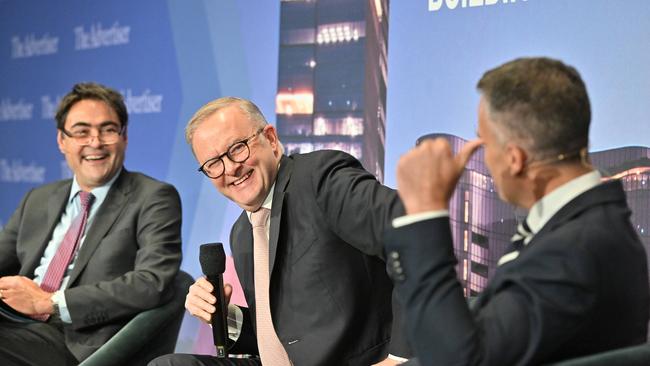Anthony Albanese and Peter Malinauskas’s big contradiction on nuclear energy
There’s a big contradiction at the heart of Labor’s policy on nuclear energy and submarines, writes Paul Starick.
Opinion
Don't miss out on the headlines from Opinion. Followed categories will be added to My News.
A gaping contradiction is at the heart of Labor’s nuclear policy, epitomised at the highest level by Prime Minister Anthony Albanese.
On one hand, the PM says AUKUS nuclear-powered submarines are “the biggest single investment in Australia’s defence capability in our history” that will help “spur the South Australian economy” by creating “thousands of jobs”.
As Mr Albanese told The Advertiser’s Future SA forum on Friday, these jobs will “keep the best and the brightest within South Australia, and attract them from across the continent”.
Likewise, Premier Peter Malinauskas is enthusiastically championing Adelaide nuclear-powered submarine construction as a key pillar of his economic strategy.
On the other hand, though, both leaders resolutely resist any prospect of nuclear power being even considered for Australia, in the face of a concerted state and federal opposition campaign.
They cling to the argument that nuclear power is uneconomic for Australia, despite a ban effectively preventing any serious and concerted market analysis.
As one business executive at the Future SA forum told The Advertiser, the economics of electricity are not being left to the market but being proscribed by politicians.

Labor has a bold policy position to embrace renewable energy and hydrogen, saying this can drive a reindustrialisation of areas like the Upper Spencer Gulf.
Whyalla’s steelworks is in talks to use green hydrogen from the $593m state-owned hydrogen plant.
At Friday’s forum, Mr Albanese argued nuclear energy was “a distraction” that diverted attention from the certainty investors needed.
“There is certainty in investing in renewables. There is certainty in investing in the sort of manufacturing breakthroughs. The investment that is taking place in Whyalla is about clearly prepared to have private sector investment putting their money where their mouth is,” he said.
Positioning himself as a pragmatist, Mr Malinauskas blamed “ideologues” for higher power prices, attacking the Greens for opposing carbon trading more than a decade ago and the Coalition for pushing nuclear power “that would on every single independent analysis make our power prices, particularly here in South Australia, far higher”.
“Every time a business or house experiences the burden of higher power prices here than what they should be in an energy superpower, they need to blame only one type of policy and that is the one that comes from the ideologues. It is the ideologues that have stuffed our power network throughout this country,” Mr Malinauskas said.

Having so enthusiastically embraced Adelaide nuclear-powered submarine construction as part of a $368bn project, neither the Prime Minister nor the Premier can credibly argue nuclear safety concerns.
Rolls-Royce, the UK firm that is supplying the nuclear reactor for the AUKUS submarines, also has a division that builds small modular nuclear reactors (SMR).
Rolls-Royce’s SMR division website says it is “bringing to market a low-cost, deliverable, global and scalable and investable solution”.
“A single Rolls-Royce SMR power station will occupy the footprint of two football pitches and power approximately one million homes. Rolls-Royce SMR is a low-cost clean energy solution, using proven and commercially available technology to deliver a fully integrated, factory-built nuclear power plant,” it says.
This is touted as generating 470MW of low-carbon energy, equivalent to more than 150 onshore wind turbines, providing consistent baseload generation for at least 60 years.
If Rolls-Royce is trusted to supply nuclear reactors for installation in Adelaide-built submarines, is not its “low-cost clean energy solution” at least worthy of consideration by state and federal authorities?
Mr Malinauskas is proposing to spend about $5bn on a desalination plant and 600km pipeline to fuel BHP’s copper expansion, centred on Olympic Dam – home of a world-leading uranium resource.
Would it not make sense to at least open market-based discussion about using this in an Australian reactor?





